The Gamma-Ray: My first Quest kit. It features a translucent red payload tube, three swept fins, and plastic nose cone and transition section. The fin stock is pretty thick and sturdy, and I like the Kevlar shock cord supplied with the kit. I painted it high-gloss metallic red with silver (stick-on) decals. I also added extra silver foil stickers to really make this model shine. I had to add a lot of nose-weight to balance this model on a string stability test, but now it flies very well - very straight. The nose-weight was glued in to the tip of the plastic nosecone, so I still have full use of the payload bay. The payload tube has vent holes added for a barometric altimeter. It can get pretty far up there with B and C motors. I bought this kit cheap as part of a package deal on eBay, didn't give it much respect. But it consistently flies well and it is growing on me. I would recommend this model, but defiantly string-stability test it with a C motor and add nose-weight as necessary, or you'll probably be very sorry you didn't. Its light enough to fly very high, but the supplied 14-inch parachute is too large unless you really pack the ounces into the payload. Even with a 18 gram payload and a 1-1/2 inch spill hole cut into the chute, it still descends at only 5 mph, allowing the wind to take it pretty far. The material Quest uses for parachutes also seems very light but too stiff, and often it will not unfurl even when plummeting down at about 30 mph. I now use a 12” Estes parachute. The other advantage of a smaller chute (aside from getting lost) is that it's easy to pack into that small, 13mm body tube. I can easily get beyond 800 feet with a C6-7 in this. This rocket has flown higher than the Rennaissance Tower in Dallas, TX and the Charlotte Bank of America Corporate Center. It could easily look down at the Trump World Tower in NY.
| Flight Date: | 2012-04-01 |
| Rocket Name: | Gamma Ray |
| Kit Name: | Quest - Gamma Ray {Kit} (2004) [1994-] |
| Flyer's Name: | Rich DeAngelis |
| Motors: | A8-3 |
| Launch Site: | Penn Manor School Lancaster PA |
| Actual Altitude: | 99 Feet |
The A8 fired for about 6/10 seconds, propelling the rocket to 46 mph. Acceleration was 3.4Gs and peaked at 8.4Gs. It then coasted for 2 seconds to an apogee of 99 feet, hardly affected by the wind gusts. The apogee, speed and acceleration were lower than normal for this model on an A8-3. After apogee it coasted an additional 1.3 seconds while falling 19 feet before the ejection fired.
The plastic parachute ejected but did not open, and the rocket fell at a fast 27 mph, for a flight time of only 6.1 seconds. I had hoped to test the new 1" spill hole I added to the 'chute to reduce the slow descent. It was not very cold, about 50 degrees F. It landed in the grass undamaged though. The ejection charge was a bit late, at 3.3 seconds.
| Stage | Motor(s) |
|---|---|
| 1 | Estes A8-3 |
Sponsored Ads
 |
 |












